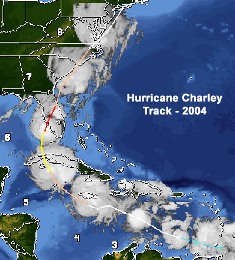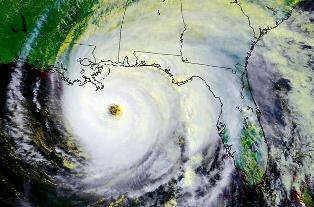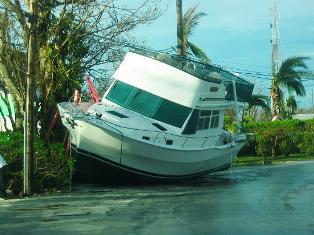Discover Florida Nature
It's time to explore the natural Florida


|
|
|
|
|
The period from 2000 to the present was marked by several devastating
hurricanes; as of 2007[update],
51 tropical or subtropical cyclones have affected the U.S. state of
Florida. Collectively, cyclones in Florida over that period resulted in
over $64 billion in damage (2008 USD). Additionally, tropical cyclones
in Florida were responsible for 69 direct fatalities and at least 80
indirect ones during the period. Eight cyclones affected the state in
both 2003 and 2005, which were the years with the most tropical cyclones
impacting the state. Every year included at least one tropical cyclone
affecting the state. The strongest hurricane to hit the state during the
period was Hurricane Charley, which was the strongest hurricane to
strike the United States since Hurricane Andrew. Additionally,
Hurricanes Jeanne, Dennis, Hurricane Katrina Wilma and Ivan made
landfall on the state as major hurricanes.  Hurricane
Charley- (2004) Hurricane Charley strengthened rapidly just
before striking the southwestern coast of Florida as a Category 4
hurricane on the Saffir-Simpson Hurricane Scale. Charley was the
strongest hurricane to hit the United States since Andrew in 1992 and,
although small in size, it caused catastrophic wind damage in Charlotte
County, Florida. Serious damage occurred well inland over the Florida
peninsula. At its peak intensity of 150 mph (240 km/h), Hurricane
Charley struck the northern tip of Captiva Island and the southern tip
of North Captiva Island, causing severe
damage in both areas. Charley, the strongest hurricane to hit southwest
Florida since Hurricane Donna in 1960, then continued to produce severe
damage as it made landfall on the peninsula near Port Charlotte. The
hurricane continued to the north by northeast along the Peace River
corridor, devastating the small cities of Punta Gorda, Cleveland, Fort
Ogden, Nocatee, Arcadia, Zolfo Springs, Sebring, and Wauchula. Zolfo
Springs was isolated for nearly two days as masses of large trees, power
pole, power lines, transformers, and debris filled the streets. Wauchula
sustained gusts to 147 mph, buildings in the downtown areas caved in
onto Main Street. Ultimately, the storm passing through East Orlando
still carrying winds gusting up to 106 mph (171 km/h). Interestingly,
the city of Winter Park, north of Orlando, also sustained considerable
damage since its many old, large oak trees had not experienced high
winds. Falling trees tore down power utilities, smashed cars, and their
huge roots lifted underground water and sewer utilities. Damage in the
state totaled to over $13 billion (2004 USD). Charley, initially
expected to hit further north in Tampa, caught many Floridians off-guard
due to a sudden change in the storm's track as it approached the state.
Throughout the United States, Charley caused 10 deaths and $15.4 billion
in damage (2004 USD), making Charley the second costliest hurricane in
United States history at the time. Hurricane
Charley- (2004) Hurricane Charley strengthened rapidly just
before striking the southwestern coast of Florida as a Category 4
hurricane on the Saffir-Simpson Hurricane Scale. Charley was the
strongest hurricane to hit the United States since Andrew in 1992 and,
although small in size, it caused catastrophic wind damage in Charlotte
County, Florida. Serious damage occurred well inland over the Florida
peninsula. At its peak intensity of 150 mph (240 km/h), Hurricane
Charley struck the northern tip of Captiva Island and the southern tip
of North Captiva Island, causing severe
damage in both areas. Charley, the strongest hurricane to hit southwest
Florida since Hurricane Donna in 1960, then continued to produce severe
damage as it made landfall on the peninsula near Port Charlotte. The
hurricane continued to the north by northeast along the Peace River
corridor, devastating the small cities of Punta Gorda, Cleveland, Fort
Ogden, Nocatee, Arcadia, Zolfo Springs, Sebring, and Wauchula. Zolfo
Springs was isolated for nearly two days as masses of large trees, power
pole, power lines, transformers, and debris filled the streets. Wauchula
sustained gusts to 147 mph, buildings in the downtown areas caved in
onto Main Street. Ultimately, the storm passing through East Orlando
still carrying winds gusting up to 106 mph (171 km/h). Interestingly,
the city of Winter Park, north of Orlando, also sustained considerable
damage since its many old, large oak trees had not experienced high
winds. Falling trees tore down power utilities, smashed cars, and their
huge roots lifted underground water and sewer utilities. Damage in the
state totaled to over $13 billion (2004 USD). Charley, initially
expected to hit further north in Tampa, caught many Floridians off-guard
due to a sudden change in the storm's track as it approached the state.
Throughout the United States, Charley caused 10 deaths and $15.4 billion
in damage (2004 USD), making Charley the second costliest hurricane in
United States history at the time. Hurricane
Frances- (2004) Category-2 Hurricane Frances came ashore on the
central east coast of Florida on September 5, 2004. Hurricane Frances
was the sixth named storm, the fourth hurricane, and the third major
hurricane of the 2004 Atlantic hurricane season. The system crossing the
open Atlantic during mid to late August, moving to the north of the
Lesser Antilles while strengthening. Frances then passed over the
central sections of the state of Florida in the U.S. only three weeks
after Hurricane Charley, causing significant damage to the state's
citrus crop, and closing schools. The storm then moved briefly offshore
Florida into the northeast Gulf of Mexico and made a second U.S.
landfall at the Florida Panhandle before accelerating northeast through
the eastern United States near the Appalachians into Atlantic Canada
while weakening. A significant tornado outbreak accompanied the storm
across the eastern United States, nearly equaling the outbreak from
Hurricane Beulah. Very heavy rains fell in association with this slow
moving and relatively large hurricane, which led to floods in Florida
and North Carolina. Some areas of Florida received over 13 inches as the
system moved slowly through the state. Heavy rains caused a large
sinkhole to develop on Interstate 95 in Palm Beach County, which closed
the highway to traffic. Frances caused heavy damage to the large Vehicle
Assembly Building at the Kennedy Space Center, ripping off over a
thousand 4-by-10 foot aluminum panels used to clad the building. A total
of 49 lives were lost from the cyclone. Damages totaled $12 billion
(2004 dollars). Hurricane
Frances- (2004) Category-2 Hurricane Frances came ashore on the
central east coast of Florida on September 5, 2004. Hurricane Frances
was the sixth named storm, the fourth hurricane, and the third major
hurricane of the 2004 Atlantic hurricane season. The system crossing the
open Atlantic during mid to late August, moving to the north of the
Lesser Antilles while strengthening. Frances then passed over the
central sections of the state of Florida in the U.S. only three weeks
after Hurricane Charley, causing significant damage to the state's
citrus crop, and closing schools. The storm then moved briefly offshore
Florida into the northeast Gulf of Mexico and made a second U.S.
landfall at the Florida Panhandle before accelerating northeast through
the eastern United States near the Appalachians into Atlantic Canada
while weakening. A significant tornado outbreak accompanied the storm
across the eastern United States, nearly equaling the outbreak from
Hurricane Beulah. Very heavy rains fell in association with this slow
moving and relatively large hurricane, which led to floods in Florida
and North Carolina. Some areas of Florida received over 13 inches as the
system moved slowly through the state. Heavy rains caused a large
sinkhole to develop on Interstate 95 in Palm Beach County, which closed
the highway to traffic. Frances caused heavy damage to the large Vehicle
Assembly Building at the Kennedy Space Center, ripping off over a
thousand 4-by-10 foot aluminum panels used to clad the building. A total
of 49 lives were lost from the cyclone. Damages totaled $12 billion
(2004 dollars). Hurricane
Ivan- (2004) Catagory3 Hurricane Ivan was the strongest
hurricane of the 2004 Atlantic hurricane season. It was often dubbed in
the media as Ivan the Terrible. It was the tenth most intense Atlantic
hurricane ever recorded. The cyclone formed as a Cape Verde-type
hurricane in early September and became the ninth named storm, the sixth
hurricane, and the fourth major hurricane of the year. Ivan reached
Category 5 strength on the Saffir-Simpson Hurricane Scale, the strongest
possible category. At its peak in the Gulf of Mexico, Ivan was the size
of the state of Texas. It also spawned 117 tornadoes across the eastern
United States. After peaking in strength, the hurricane moved
north-northwest across the Gulf of Mexico to strike Gulf Shores, Alabama
as a strong Category 3 storm, causing significant damage. Ivan dropped
heavy rains on the Southeastern United States as it progressed northeast
and east through the eastern United States, becoming an extratropical
cyclone. The remnant low from the storm moved into the western
subtropical Atlantic and regenerated into a tropical cyclone, which then
moved across Florida. Ivan caused an estimated $13 billion (2004 USD) in
damages to the United States. Hurricane
Ivan- (2004) Catagory3 Hurricane Ivan was the strongest
hurricane of the 2004 Atlantic hurricane season. It was often dubbed in
the media as Ivan the Terrible. It was the tenth most intense Atlantic
hurricane ever recorded. The cyclone formed as a Cape Verde-type
hurricane in early September and became the ninth named storm, the sixth
hurricane, and the fourth major hurricane of the year. Ivan reached
Category 5 strength on the Saffir-Simpson Hurricane Scale, the strongest
possible category. At its peak in the Gulf of Mexico, Ivan was the size
of the state of Texas. It also spawned 117 tornadoes across the eastern
United States. After peaking in strength, the hurricane moved
north-northwest across the Gulf of Mexico to strike Gulf Shores, Alabama
as a strong Category 3 storm, causing significant damage. Ivan dropped
heavy rains on the Southeastern United States as it progressed northeast
and east through the eastern United States, becoming an extratropical
cyclone. The remnant low from the storm moved into the western
subtropical Atlantic and regenerated into a tropical cyclone, which then
moved across Florida. Ivan caused an estimated $13 billion (2004 USD) in
damages to the United States.
|
|
|
Advertise | Privacy Statement | Dog Encyclopedia | Video |Contact | Alaska Nature |
|